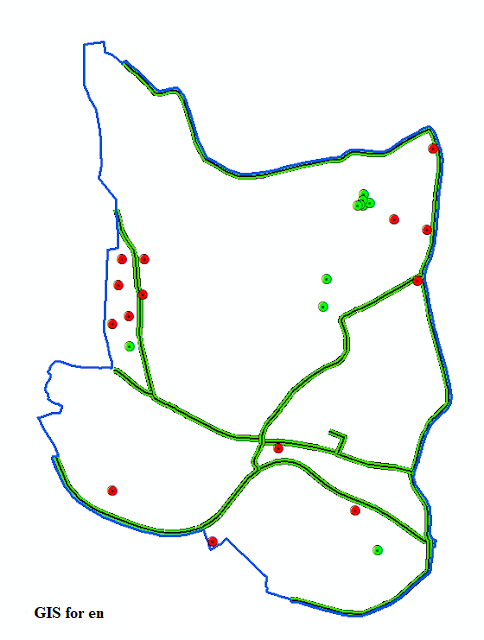GIS Analyst
 |
| GIS Analyst |
Spatial analysis in an ArcGIS environment
Basic methods and concepts through which to become a GIS Analyst using ArcGIS software
Introduction to the meaning of analysis
Analysis is methods, methods and practical experience possessed by a person interested in a particular specialty. Through these qualities, a person can understand all the scientific bases, theoretically and practically, according to his academic specialization or interest. For example, a person can specialize in the field of computer engineering and web programming languages and have an interest in Geographical information systems programs and with practice and experience become a data analyst such as a person specializing in geography or surveying, we add to this that computer and programming disciplines support ArcGIS programs in a very large way, especially in displaying databases on the Internet.
Analysis in an ArcGIS software environment
Following up on the above in the introduction to the analysis, the analysis stage in geographic information systems (GIS) enters a second stage of development after the stage of creating and managing geographical databases,
Meaning, we cannot do the analysis without ready-made data and layers. In addition, the quality of the data within the geographical database must be excellent, without errors in drawing or spreadsheets.
If after accessing a geographical database that contains a lot of data represented in raster data, vector data and tables (Raster, Vector and Table), the analysis phase begins to understand this data and how through it other layers are extracted and new data entry methods are made from existing data such as code, and modeling A set of tools to make it a single tool through which to update the existing data and check the quality of the data by detecting the error rate for example.
GIS Analyst
One of the components of GIS science is people, including a manager, developer, user, and also an analyst. To become a GIS analyst specifically in ArcGIS programs, you must be characterized by a set of qualities, including the following:
- A comprehensive diverse ability in the initial visual analysis when looking at any geographic database data with spreadsheets, in addition to existing images and maps such as remote sensing and aerial photography outputs.
- Understanding the distribution of the patterns of geographical features and phenomena and knowing the density of the distribution to know the areas that include data density and less dense areas, in addition to studying and understanding the features and phenomena within the geographical database.
- Finding ways and methods to save time and effort in dealing with geographical base data.
- Selection of the most suitable sites (Spatial Suitability Analysis) and future prediction of geographical features.
- Work with all types of data encoding and quantitative and qualitative representation (distribution maps, color gradients, shapes of all borders and points, in addition to coding according to the geometric shape, columns, circles, etc.).
- Understand the geometric properties of all phenomena and features in terms of area, perimeter, coordinate systems, and the relationship of the geometric figure by setting topological rules according to all vector layers.
- Establishing relationships between all data and linking them so that it becomes an integrated network or fabric that shows this through the query tool.
- Determining the geometric relationships with three-dimensional (3D) features and in the relationships characterized by time and time (4D).
- Understand the environment and structure of raster data through cell size, interpolation and interpolation through interpolation analysis.
- Analysis of terrain and surfaces by outputting raster data representing a digital elevation model (DEM), irregular triangular network (TIN) and other 3D analyzes that represent the true shape of the Earth within the geographical database.
Strengthening spatial analysis
There are steps that a GIS analyst must follow to ensure a successful spatial analysis:
- Ask questions that help him develop geodatabase data.
- Examine the data to reach strong data quality and make the layers a single fabric so that all geographical features and phenomena are linked by clear geometric rules and comprehensive data tables that describe all the features as required.
- Flexibility in solving problems so that the data is solvable when using any type of analytics.
- Produce maps and reports to decision makers to help them support and take appropriate decisions in development and progress according to the goal of using GIS science and programs.
benefits of spatial analysis
There are many benefits of using spatial analysis in the ArcGIS software environment. We mention the most important of these benefits through:
- Achieving the desired goals of any project.
- Support the results through maps and reports.
- Saving time, effort and cost in the required projects.
Examples of Spatial Analysis Types in ArcGIS Software
- Dealing with data spatially to facilitate access to the target through the operations: Extraction, Overlay, Proximity, Statistics with table output.
- Network analysis, especially road networks.
- Engineering network analysis, especially sewage and water networks (Geometric Network).
- Hydrological analysis to explore wadi drainage basins through a digital elevation model (DEM).
- Parcel Fabric Analysis.
- Relationship analysis.
- Use of all types of analyzes through Model Builder.
- Spatial Suitability Analysis to choose the best location for any project.

Comments
Post a Comment